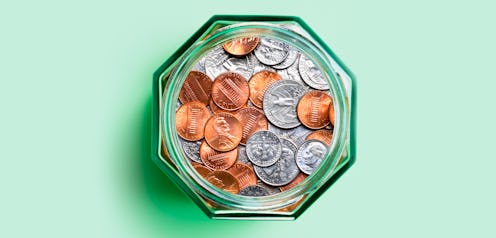
If you're anything like me, you probably live on a budget; how you manage that budget, however, usually varies from person to person. Recently, though, I've discovered a new method which has the potential to work well for most people, including those new to budgeting: The budget jar method. What is the budget jar method, exactly? It's pretty straight forward: Basically you take six jars (literal or metaphotical) and assign them each a purpose. For example, one jar could be for rent, one jar could be for entertainment, etc. Budgeting works differently for everyone; some people take a pretty lax approach and simply monitor their account balance, while others use apps to monitor their daily spending. But if you're trying to save money, budgeting is pretty integral because it lets you know exactly how much you're spending, including what you can cut down on — and if keeping track of everything can be a struggle for you, the budget jar method may help.
Now, this method obviously is most effective with actual cash and actual jars if you're looking at it for the visual incentive. Personally, I do the majority of my spending from my debit account, so I rarely have cash on my person. If you're in a similar position to mine, I think you could get a similar effect if you gathered a couple of actual jars and put a sticky note on each jar, updating the amount "available" in each section as you spend it or save it. That way, you'll be able to see your habits reflected visually on the jar itself, even if you're moving all your money electronically.
Some studies do show that people spend less when they pay with cash, so if you're looking to save money, that might be a good approach to take. There are also many customizable budget apps which allow you to "sort" your budget into categories, so you could take the "jar method" into the virtual world as well.
Below, I've outlined the six basic components of the jar method, with some suggestions for variations from my own perspective. With budgeting, you should of course go with what works best for you and your specific needs, so go ahead and adapt the system however you like.
1. Basic Living Expenses
Over at Bright Side, they recommend making the first jar 55 percent of your budget. This jar should cover rent, utilities, transportation, taxes if you're a freelancer, and food. For me personally, these expenses make up more than 55 percent of my budget, so I'd probably break this into more than one jar to keep an eye on my spending; for instance, I'd probably make my food jar separate, or make a separate jar for "groceries" and "going out to eat."
2. Fun Stuff
Bright Side recommends using 10 percent of your budget on entertainment. This could be a nice bottle of wine, a trip to the movies, or getting a few cocktails with friends at the bar. As someone who lives in a city, entertainment can become expensive quickly depending on what it is, so this is another jar I'd have to strategically spend to get the most "value" out of the experience. But hey, don't forget that there are lots of free events available in many cities, too — fun doesn't have to mean costly!
3. Long-Term Savings
It's recommended you put another 10 percent of your savings into a long-term savings jar. Basically, this is money that's off-limits except to plan for your future. Many people suggest trying to earn interest on this portion of your budget and create passive income that way.
4. Education
Bright Side recommends using 10 percent of your budget on educational expenses like books or other instructional materials. As a graduate student, there is no way I spend 10 percent of my budget on school-related expenses; I definitely spend much, much more, especially if I consider my student debt. For me, this part of my budget expands when the semester begins and I need to invest money in books and school supplies, but wanes during the holidays and summer. This is another example of a situation where you should make your budget work for your own needs.
5. Private Reserves
This 10 percent of your savings should go towards your large purchases. For instance, if you're buying an annual membership at your local yoga studio or buying a new computer, you'd dip into your "reserves" for the purchase. Ideally, you'd replenish the reserve ASAP and not make another big purchase until you had enough money saved back up.
6. Gifts
And for the final five percent of your budget, Bright Side recommends saving it for gifts or charitable donations. For me, this amount definitely goes up around the holiday season, so I'd probably save more during the fall months and splurge during the winter.
Regardless of which approach to budgeting you take, it's important to pick something that works best for you. It's OK to combine methods or use different approaches simultaneously (say, for long-term versus short-term budgeting, or personal versus familial planning) if that's what works best for you. Either way, though, I can't speak strongly enough about how important it is to maintain a budget. Even if you're living well now, you never know what the future holds, and having a savings account you can rely on could be a savings grace during a rough period in your life, or when a friend or loved one is in need.
Images: Peter Dazeley/Photodisc/Getty Images; Giphy (7)